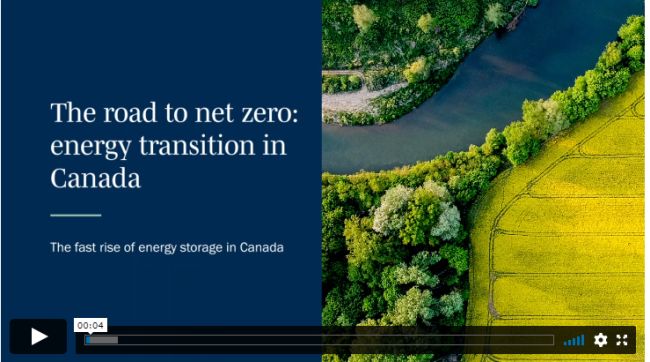- with Senior Company Executives, HR and Finance and Tax Executives
- with readers working within the Banking & Credit, Insurance and Healthcare industries
Energy storage may be the newest entrant on the electricity grid, but businesses involved in growing this power source are making up for lost time. Ontario is a prime example, where the Independent Electricity System Operator issued a landmark request for proposal and has evolved its regulatory framework to match industry growth.
In this video, Milosz Zemanek, Krista Hill and Henry Ren take a look at the current state of play, which echoes the promise of wind and solar projects 15 years ago-and anticipates the bright future of energy storage projects in Canada.
Click here to see other videos and webinars in this series.
Video transcript
Milosz Zemanek (00:07): Hi and welcome to the latest installment of Torys' energy transition series. My name is Milosz Zemanek, I'm a Partner in the Debt Finance Group. I'm the Head of the Torys Energy Storage Practice and I'm a one-time Director and Chair of Energy Storage Canada, Canada's Energy Storage Industry Association. I'm joined today by my colleagues Krista Hill and Henry Ren, and we're going to talk about one of the newest kids on the electricity block, energy storage.
Krista Hill (00:38): We're definitely seeing a huge interest in energy storage. And I think there's going to be significant growth in Canada, particularly in Ontario, in energy storage this decade. We see the IESO has released the long-term RFP earlier this year. They're really looking for resources that can be online quickly in the next 3 to 5 years. And I think everyone's anticipating that the overwhelming responses to this RFP are going to be energy storage projects. And initiatives like this I think we're really going to see drive significant growth in energy storage this decade and beyond.
Milosz Zemanek (01:21): And you're absolutely right, Krista. It's great to see the Ontario government from a public policy perspective come out with this RFP. Obviously, it's not something people may have expected a few short years ago, but obviously that's just one side of it. There are some other aspects to it. I am specifically thinking here about the regulatory side.Henry, from what you've seen today, what do you think is going on, on that end?
Henry Ren (01:51): The business case for energy storage-we really can't talk about it apart from the regulatory framework that underpins all of this, right? So if we look at Ontario, aside from the RFP Krista has been talking about, it's interesting that the RFP is taking place in conjunction with and in parallel with the fast evolution of regulatory rules as well as system operating tools by IESO to integrate and enable storage. To think about it, it's fascinating and it's impressive in a way that up until a couple of years ago, there really wasn't any specific explicit recognition of energy storage resources, in the IESO market rules. All of this is happening sort of on an interim design basis in the past couple of years. And the more permanent solutions are being put in place going forward.
Milosz Zemanek (02:41): And I should mention here that, you know, unlike in the US where there is a national electrical energy regulator, a few years ago issued an order that required energy storage to become part of the wholesale market and required energy systems' operators to make sure that all barriers to energy storage being in that market were removed. Here we've got a bit of a patchwork, with both of you-Krista you on the RFP side and Henry on the regulatory side-are you seeing any movement there in terms of Ontario potentially trying to catch up in a manner of speaking with something like a FERC Order 841? Obviously not exactly like that, we don't have that kind of regulator, but just in terms of where we are substantively going.
Krista Hill (03:32): Yeah, I think Milosz you're right like you definitely see the RFP is really there to jump start the introduction of these projects, energy storage projects through the Ontario grid in a large scale way and that policy intervention by the IESO, I think as a result we are going to see a huge amount of growth in energy storage this decade, similar to the way we did in wind and solar projects. You know, 10-15 years ago where the IESO and its predecessor, the Ontario Power Authority, really went out with a FIT program, contracts, RFPs that really jumpstarted and created that renewable energy boom we experienced.
Henry Ren (04:23): And even within Ontario itself, just on that lack of a national regulator that Milosz was alluding to, there is sort of this multi-agency approach, not only with IESO in terms of amending updating its tools and market rules, but also from the Ontario Energy Board perspective, which is primarily concerned with consumer protection and utility regulation. It's also working in consultation with industry to try to clarify the regulatory treatment around the connection and cause recovery of these new non-wire solutions, which include energy storage. So how all of that is going to play out is something that provides uncertainties but also benefits because to a large extent, industry in some regards is driving this consultation, providing input and working closely with both OEB and IESO to make sure we have a sustainable and efficient framework for energy storage going forward.
Krista Hill (05:18): I think, Henry, no matter which way we cut it, it's a bright future for energy storage in Ontario and Canada, generally.
Milosz Zemanek (05:28): Thanks for watching. For more of our energy work, head to www.torys.com.
The content of this article is intended to provide a general guide to the subject matter. Specialist advice should be sought about your specific circumstances.




